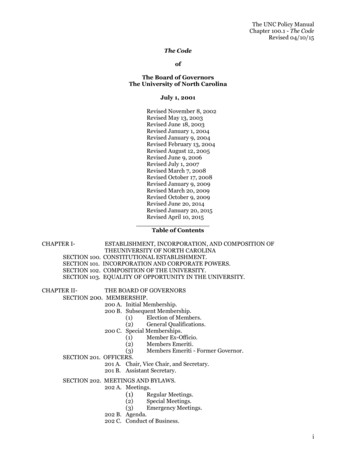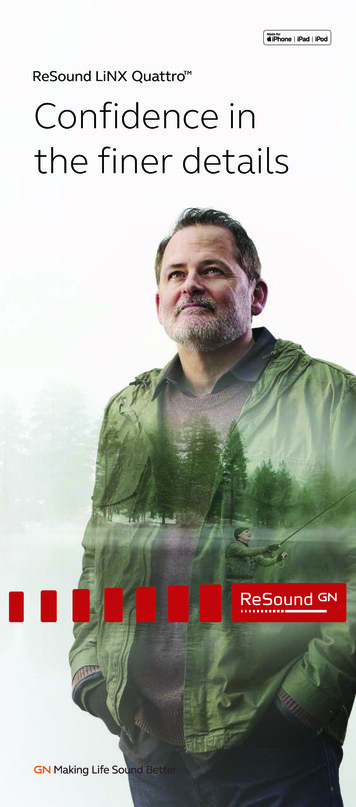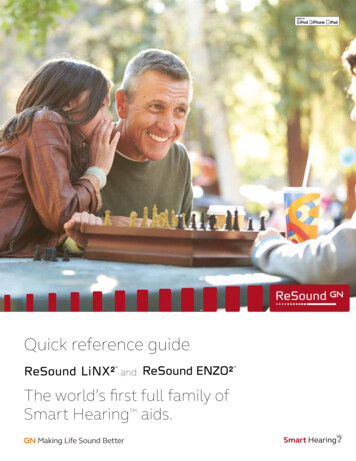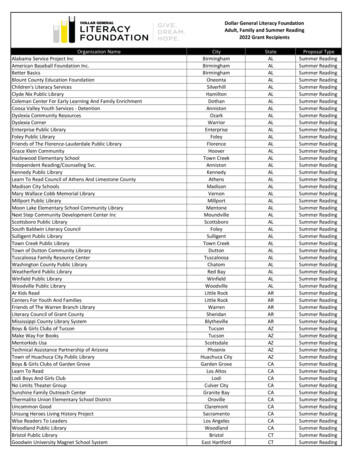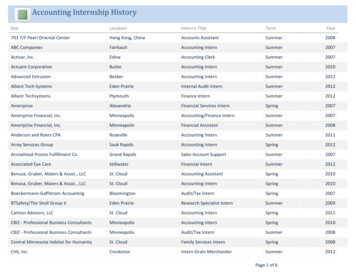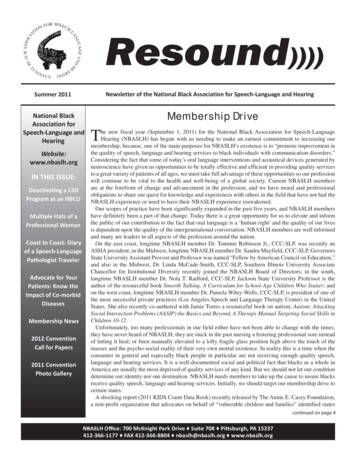
Transcription
Resound))))Newsletter of the National Black Association for Speech-Language and HearingSummer 2011National BlackAssociation forSpeech-Language andHearingWebsite:www.nbaslh.orgIN THIS ISSUE:Deactivating a CSDProgram at an HBCUMultiple Hats of aProfessional WomanCoast to Coast: Diaryof a Speech-LanguagePathologist TravelerAdvocate for YourPatients: Know theImpact of Co-morbidDiseasesMembership News2012 ConventionCall for Papers2011 ConventionPhoto GalleryMembership DriveThe new fiscal year (September 1, 2011) for the National Black Association for Speech-LanguageHearing (NBASLH) has begun with us needing to make an earnest commitment to increasing ourmembership; because, one of the main purposes for NBASLH’s existence is to “promote improvement inthe quality of speech, language and hearing services to black individuals with communication disorders.”Considering the fact that some of today’s oral language interventions and acoustical devices generated byneuroscience have given us opportunities to be totally effective and efficient in providing quality servicesto a great variety of patients of all ages, we must take full advantage of these opportunities so our professionwill continue to be vital to the health and well-being of a global society. Current NBASLH membersare at the forefront of change and advancement in the profession, and we have moral and professionalobligations to share our quest for knowledge and experiences with others in the field that have not had theNBASLH experience or need to have their NBASLH experience reawakened.Our scopes of practice have been significantly expanded in the past five years, and NBASLH membershave definitely been a part of that change. Today there is a great opportunity for us to elevate and informthe public of our contribution to the fact that oral language is a ‘human right’ and the quality of our livesis dependent upon the quality of the intergenerational conversation. NBASLH members are well informedand many are leaders in all aspects of the profession around the nation.On the east coast, longtime NBASLH member Dr. Tommie Robinson Jr., CCC-SLP, was recently anASHA president; in the Midwest, longtime NBASLH member Dr. Sandra Mayfield, CCC-SLP, GovernorsState University Assistant Provost and Professor was named “Fellow by American Council on Education,”and also in the Midwest, Dr. Linda McCade-Smith, CCC-SLP, Southern Illinois University AssociateChancellor for Institutional Diversity recently joined the NBASLH Board of Directors; in the south,longtime NBASLH member Dr. Nola T. Radford, CCC-SLP, Jackson State University Professor is theauthor of the resourceful book Smooth Talking, A Curriculum for School-Age Children Who Stutter; andon the west coast, longtime NBASLH member Dr. Pamela Wiley-Wells, CCC-SLP, is president of one ofthe most successful private practices (Los Angeles Speech and Language Therapy Center) in the UnitedStates. She also recently co-authored with Jamie Torres a resourceful book on autism, Autism: AttackingSocial Interaction Problems (AASIP) the Basics and Beyond, A Therapy Manual Targeting Social Skills inChildren 10-12.Unfortunately, too many professionals in our field either have not been able to change with the times;they have never heard of NBASLH; they are stuck in the past nursing a festering professional sore insteadof letting it heal; or been manually elevated to a lofty fragile glass position high above the touch of themasses and the psycho-social reality of their very own mortal existence. In reality this is a time when theconsumer in general and especially black people in particular are not receiving enough quality speech,language and hearing services. It is a well-documented social and political fact that blacks as a whole inAmerica are usually the most deprived of quality services of any kind. But we should not let our conditiondetermine our identity nor our destination. NBASLH needs members to take up the cause to insure blacksreceive quality speech, language and hearing services. Initially, we should target our membership drive tocertain states.A shocking report (2011 KIDS Count Data Book) recently released by The Annie E. Casey Foundation,a non-profit organization that advocates on behalf of “vulnerable children and families” identified statescontinued on page 4NBASLH Office: 700 McKnight Park Drive Suite 708 Pittsburgh, PA 15237412-366-1177 FAX 412-366-8804 nbaslh@nbaslh.org www.nbaslh.org
Deactivating a CSD Program at an HBCUAdecision to close an academic program at any institution ofhigher education can have serious implications; certainlyfor would-be students, but also the faculty, the university and thecommunity-at-large. If that decision has to be made, it should bedone in a deliberative manner, one reflective of the circumstanceor circumstances that may have prompted it.In May 2011, the faculty and university administrators atNorfolk State University (NSU), Norfolk, Virginia, deactivated its42-year-old undergraduate training program in CommunicationSciences and Disorders (CSD). NSU’s program was one of thefew remaining undergraduate programs at a Historically BlackCollege or University (HBCU). The decision to deactivate theprogram was based, officially, on a 10-year steady decline inundergraduate CSD enrollment. Its largest enrollment was in1999, with 36 students, but in the fall of 2010 enrollment hadfallen to only five students. Unofficially, it was determined by thefaculty that none of the five remaining students at the end of fallsemester 2010 had earned grades sufficient enough to make themeligible for admission to any graduate training program in CSD.Continuing their enrollment, based on their current academicperformances, would, with certainty, have hurt their grade pointaverages (GPA), as well as their chances of getting into graduateschool, even in some other discipline. As a consequence, each ofthe remaining students was urged to drop the major and transferto some other discipline. Figure 1 (below) shows a representativesample of the percentage of CSD students (1999-2011) whomet eligibility requirements (i.e., GPA) for graduate programadmission at the time of their graduation.In reflection, the CSD faculty recalled that at the height ofenrollments (1999-2000) there was a noticeable change in theprofessional “attitude” of entering students. Fewer studentspresented with dedicated interests in the health sciences, and manyseemed to have an “altered” view of speech pathology, thinkingsomehow that it related more to special education than to health orrehabilitation. The faculty recalled that students would state theydid not want to “deal with” large class sizes, like teachers, and thatspeech pathology had “small classes” and was more appealing.Also, few students seemed academically prepared for the rigorof the health and science based speech pathology and audiologycourses, which they were required to take. The sentiment of justwanting to “get out of school with a good paying job,” seemedquite prevalent.2NBASLH RESOUND))))SUMMER 2011Reports from students leaving the program (circa 2005) suggested: That there were too few “hands-on,” practical experiencesor simulations in speech pathology to make the classes more“enjoyable.” There was much more academic work (i.e., reading, writingdiscussions, library studies, etc.) than what was expected. The required professional behavior and decorum (i.e., dresscode, proper speech) were more than what was expected. Having to definitely go to graduate school after getting abachelor’s degree was a problem (many had to go to work topay back loans, parents, etc.).A Glimmer of HopeOut of the deactivation of the CSD program comes one glimmerof hope. In the midst of closing the program the faculty waspermitted to transfer the core CSD courses (i.e., phonetics, A &P, speech science, neurogenics, audiology and aural rehab) tothe University’s School of Extended Learning where they weremade available for online instruction. The CSD curriculum isnow targeting “career-changers,” older students interested ingraduate CSD training, but who need undergraduate prerequisitecoursework. This program appears to have a growing potentialand promises to keep communication sciences and disorders aliveat NSU, albeit, in a virtual environment.There is no doubt that the Communication Sciences andDisorders program at NSU can be proud of its history. Overthe past four decades, scores of the program’s graduates, andseveral of its faculty, went on to achieve local, regional, nationaland international recognitions and honors. Yet, the fact that theprogram lost enrollment had to be deactivated should give uspause to consider what might be going on with other programsexperiencing similar circumstances. Even one such deactivationshould caution us that it could happen elsewhere.Dr. Ronald Jones is still a Professor ofCommunication Sciences and Disorders in theDepartment of English and Foreign Languagesat Norfolk State University, Norfolk, VA. Formore information about the CSD program’sdeactivation and/or information about NSU’sonline prerequisite CSD program, contact Dr.Jones by e-mail at rjones@nsu.edu, or by phoneat 757 823-2365.Do you have news to share?Members are encouraged to submit items for consideration andpublication in the Resound)))). Topics include articles of interestto the membership and areas that pertain to SLPs or audiologists.Share your good news and accomplishments!If you have a story, announcement or event you would like to placein the Resound)))), please send your information to:Diane Yenerall, MPM, CAENBASLH Business Managernbaslh@nbaslh.org
Multiple Hats of a Professional WomanNBASLH Executive BoardSeptember 1, 2011 - August 31, 2012Arnell Brady, Chairaaarnell@aol.comLinda McCabe Smith, Treasurerlsmith@siu.eduCarolyn Mayo, Secretaryjthgug@gmail.comcmmayo@ncat.eduRachel Williams, Convention Chairrachwill@nova.eduAs with many health care professionals, multiple hats may be wornthroughout life based on multiple responsibilities of life. Multipleresponsibilities may be described as and/or viewed as time-consuming,demanding, conflicting and at times awe-inspiring, although managingone’s skills among multiple roles, may appear to others as effortless.Transitioning from one hat to another is an art, and may be viewedas dynamic. Despite what combined tasks and/or sentiments come tomind, wearing and systematizing multiple hats has become a dailyroutine of many certified/licensed speech-language pathologists (SLPs)across the nation. Like many health care professionals, SLPs share twothings, a personal life and a professional life.Along with other factors, one’s personal life may supersede one’sprofessional life or vice versa, depending upon where one is in life and where one aspiresto be, personally and/or professionally.As for me, at this point in my life, with God’s guidance, managing my personallife, expanding my career and broadening my education at the doctoral level at NovaSoutheastern University are my multiple hats of life.What multiple hats of life are you wearing?!Michele Norman, PRAXIS Chairdrmlnorman@gmail.comnormanml@longwood.eduOpal D. Williams, MEd, CCC-SLP, Founder & CEO of Communication 360 LLCWebsite: www.communication360llc.comUndergraduate studies: Speech Language Pathology at NC A&TGraduate studies: Communication Sciences & Disorders at NCCUPost graduate studies: Doctor of Education Candidate with dualConcentrations in Speech-Language Pathology and Health CareEducation at Nova Southeastern UniversityByron Ross, Parliamentarian/Awardsblross@central.uh.eduKatrina Miller, Affiliatesmillerk@nccu.edutalk4mekm@aol.comJamila Foreman, Resound))) Editorjamila.foreman@gmail.comRonald Jones, ECHO Editorrjones@nsu.eduSilvia Martinezsmartinez@howard.eduKia Johnsonjohns3kn@jmu.eduFrederick TurnerStudent Representativefreddiet38@hotmail.comDiane YenerallNBASLH Business Manager700 McKnight Park Drive, Suite 708Pittsburgh, PA 15237412-366-1177412-366-8804 (Fax)nbaslh@nbaslh.orgCoast to Coast:Diary of a Speech-Language Pathologist TravelerAs a speech-language pathologist (SLP) traveler, I have had the opportunity to explorethe country and advance my career. For more than a year these contractual positionshave exposed me to diverse populations, disorders and SLPs who share the same passionfor our growing profession.I realized quickly that being an SLP traveler placed me in the driver’s seat of my career.On this journey I obtained a lot of experience in a short period of time and learned toadapt to facility specific protocols while maintaining ASHA’s Code of Ethics. Workingwith SLPs trained at various institutions elevated my clinical expertise of diagnosingand treating adults with neurologically based disorders. Although all of my assignmentshold a special place in my heart, my most memorable assignment was Valley BaptistMedical Center in Brownsville, Texas. This placement submerged me in a multiculturalenvironment. The majority of my patients were Spanish-speaking and of Mexican descent.As a minority in this environment, I embraced learning a new culture and language tomeet the functional needs of my patients and their families. I shared information fromother successful SLP programs and together my colleagues and I learned from each otherwhile advancing the level of care provided to each patient.As I box up my traveling shoes that have taken me to the snow capped mountainsof Western Maryland; to the beautiful city of Chicago, Illinois; to watch the sunset offthe Chesapeake Bay; to run along the roaring ocean in South Padre Island, Texas; toexperiencing the city of the Dallas Mavericks; and to painting the town purple in the cityof the Baltimore Ravens, a new zip code every three months has been adventurous. Thissteady fresh start created nationwide networking avenues for me in the field of speechlanguage pathology.My favorite quote by Lawrence K. Fish – “Find life experiences and swallow themwhole. Travel. Meet many people. Go down some dead ends and explore dark alleys. Tryeverything. Exhaust yourself in the glorious pursuit of life.”Davetrina Seles Gadson specializes in adult neurological disorders.She graduated from South Carolina State University with a Bachelors ofArts degree in Speech-Language Pathology and Audiology and TowsonUniversity with a Master of Science degree in Speech-Language Pathology.3NBASLH RESOUND))))SUMMER 2011
Advocate for Your Patients: Know theImpact of Co-morbid DiseasesMembership Drivecontinued from page 1SLPs must understand the importance of knowing the impactof co-morbid diseases when treating our patients. Diabetes,heart disease, hypertension and high cholesterol have all beenshown to increase the risk of stroke and have also been linked toAlzheimer’s Disease.As an SLP in an adult setting, it is often necessary to educatepatients and caregivers on risk factors to prevent additional strokesand to provide additional information that can contribute to theoverall wellness of the patient. When dealing with multiculturalpopulations, SLPs should be aware of health disparities anduse this knowledge to advocate for the patient and educate thepatient and caregivers. While we may have been consulted todeal with communication, cognitive or swallowing deficits thathave resulted after a stroke, our job is to also contribute to theprevention of another stroke. This can be a sensitive subject,because many of these related diseases are caused by lifestyle anddiet. Partnering with a dietician may be beneficial in educatingpatients and families on alternatives to culturally specific foods.Also, knowledge of resources and support groups in the patient’scommunity is vital to providing additional education and supportfor the related diseases and stroke prevention.Thoroughly assessing memory and problem-solving, especiallyas it relates to medication management and insight/judgmentis critical to the patient’s overall well-being. It may necessitateidentifying a reliable caregiver to administer or supervisemedications and additional disease management activities, suchas monitoring blood-glucose levels.Having general knowledge of the normal ranges or patientspecific parameters for blood pressure, heart rate, temperature andblood-glucose levels will aid the SLP in identifying if there areany changes in the patient’s health which may increase the riskfor stroke. Usually, the SLP is a member of an inter-disciplinaryteam which includes a doctor and a nurse, however, the therapistmay need to communicate changes in the patient’s condition toalert the doctor and prevent additional complications. Do notassume that the patient or the caregiver is fully educated on themanagement of the patient’s diseases or changes in conditionsthat should be reported. If additional information is needed, thatis beyond the scope of practice, the SLP should consult with thecase manager, who is usually an RN, and ask that they provideadditional education on disease and/or medication management.The SLP who truly partners with the patient, the caregiversand the other members of the inter-disciplinary team is anecessary contribution to over-all wellness of the patient. Havingknowledge of co-morbid diseases will increase the SLP’s role inthese partnerships and make the SLP a stronger advocate for thepatient. For more information on risk factors of stroke for AfricanAmericans, visit www.stroke.org. For more information on riskfactors for stroke for Hispanics visit www.strokeassociation.org.Jamila Perry Foreman, MEd, CCC-SLP is aSLP in a home care setting, Owner/President ofFind Your Voice: Communication Specialists,PLLC and the editor of the Resound))). Foradditional information visit her websites www.fyvcommunicationspecialists.com or ists.4NBASLH RESOUND))))SUMMER 2011where it is good and safe to raise children and states where it isbad and unsafe to raise children. For our membership drive wewill initially focus on the 21 worst states in terms of child safetyand well-being, because that’s where our help is sorely needed. Inother words, we started from the bottom (the most deprived, theleast likely to receive quality services, the least likely to survive)or the worst State (Mississippi) with a rank of 50 and worked upto number 30 (Michigan) on the list, to get our 21 worst states interms of child well-being.The 21 worst states in terms of overall child well-being islisted on the next page, a comparison can be made betweenthe percentage of black people in the state, the number ofNBASLH members, and the number of black members in theAmerican Speech-Language-Hearing Association (ASHA). Themembership count includes speech-language pathologists andaudiologists. The comparison was made to give us an idea of thepercentage of speech-language pathologists and audiologists thathave openly made a commitment and joined in a concerted effortto improve the quality of speech, language and hearing services toblack individuals in their state and the potential for growth.Humans are social animals. We have a strong need to belong.Much of our self-identity is shaped by the social groups wherewe are members. Some of those groups we are born into, muchlike our ethnic identity and sexuality. Then there are those groupsthat we choose to be a part of because of our self-interest. Addedto this list should be groups and associations that we need tobelong to in order to survive and thrive. NBASLH is one of thoseassociations that are involved with surviving and thriving. Weneed more professionals that are ready to survive and thrive. JoinNBASLH now!Arnell A. Brady, MA, CCC-SLP/LNBASLH Chairman, 2011-2013National Board of DirectorsMembership NewsStarting Fall 2011, Byron Ross will begin as AssistantClinical Professor at the University of Houston in theDepartment of Communication Sciences and Disorders. Byronserved on the faculty at the University of Central Arkansas for11 years and is very excited about his new position.
Breakdown of NBASLH and ASHA Members in Relation to Their StateStateRankBlack persons, percent oftotal state populationNBASLH Members(SLP & A)ASHA Black Members(SLP & 6.20%180Arkansas4715.40%1261New Mexico462.10%15South Carolina4527.90%8213West 916.70%13122North 14.20%101052012 Convention Call For Papers2012 Convention Raleigh Marriott City Center Raleigh, NC April 19-22, 2012NBASLHMark Your Calendars2012 NBASLH Convention Call for Papers DeadlineNovember 1, 2011Membership Renewals MailedEarly November, 2011Shapingthe FutureEducational programs can be in the form of sessions or posterpresentations. To submit your Call for Paper, log on to the NBASLHwebsite, www.nbaslh.org.Deadline for submissions is: November 1, 2011.If you have any questions, please contact the NBASLHOffice at 412-366-1177 or nbaslh@nbaslh.org.Raleigh Marriott City CenterStandard Room Rate: 135Nomination for NBASLH Board of Directors DeadlineJanuary 31, 2012Convention Program MailedFebruary, 2012Nomination for NBASLH Awards DeadlineFebruary 1, 2012NBASLH Scholarship DeadlineFebruary 15, 2012NBASLH 2012 ConventionApril 19-22, 2012PRAXIS ReviewApril 19-22, 2012Check www.nbaslh.org for Event Updates and Reminders!
2011 Convention Photo GalleryAntoine Bethea and Rachel Wiliams atAwards DinnerAraine McWhinney, Rachel Williams,Melissa Edrich and Mary Ann LoweRaquel Garcia at Awards DinnerCathy Runnels and Byron Ross atGospel BreakfastGuest Panel at Student-Mentor LuncheonGroup Dancing at Awards DinnerArnell Brady with students at Student-MentorLuncheonFred Turner at StudentMentor LuncheonJaquetta Perry Praise Dance atGospel BreakfastLekeita Emanual and Terlenda Crawford atGospel BreakfastIris Arnold Johnson and RachelWilliams Group Wobble Dance atAwards DinnerASHA Members with students at Student-Mentor LuncheonIris Arnold Johnson with students at Student-Mentor LuncheonCarney Soto with Students at Student-Mentor LuncheonMichele Norman at Gospel BreakfastMichele Norman and Byron Ross with students at Student-Mentor LuncheonMichele Norman and Iris Arnold Johnsonat Awards DinnerCarolyn Mayo and Jonathon Love with studentsat Student-Mentor LuncheonRon Jones and Paula Leslie with students at Student-Mentor Luncheon6NBASLH RESOUND))))SUMMER 2011
2011 Convention Photo GalleryNBASLH Members at Gospel BreakfastRon Jones at Gospel BreakfastGroup at Gospel BreakfastRachel Williams and Arnell Brady at GospelBreakfastEnsley Graves and Regina Lemmon at Gospel BreakfastRachel Williams and Iris Arnold Johnson atAwards DinnerSoloris Greene and Maggie Tshule at GospelBreakfastStudents at Gospel BreakfastRachel Williams, Michele Norman and Jackie Moore at GospelBreakfastWanda Miller and her mother at the Gospel BreakfastSylvia Martinez, Kara Taylor and Byron Ross at StudentMentor LuncheonStudents at Gospel Breakfast7NBASLH RESOUND))))SUMMER 2011
millerk@nccu.edu talk4mekm@aol.com Jamila Foreman, Resound))) Editor jamila.foreman@gmail.com Ronald Jones, ECHO Editor rjones@nsu.edu Silvia Martinez smartinez@howard.edu Kia Johnson johns3kn@jmu.edu Frederick Turner Student Representative freddiet38@hotmail.com Diane Yenerall NBASLH Business Manager 700 McKnight Park Drive, Suite 708 .


